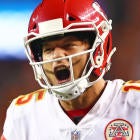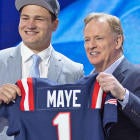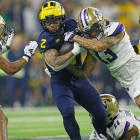One way drafters could have recognized Patrick Mahomes' upside last season was a popular analytical method of analyzing the relationship between the Average Draft Position of quarterbacks and the skill position players around them to find inefficiencies in the market.
Mahomes was leading an offense that featured Travis Kelce, Tyreek Hill and Kareem Hunt as top-25 draft picks, but he was just the 15th quarterback selected, per MyFantasyLeague ADP.
When the relationship runs this way, it typically points to either an undervalued quarterback or potentially overvalued skill position players. When it runs the other way, we may be able to identify skill position opportunities or quarterbacks the draft market is too bullish on.
Here is what that relationship looks like for each team in 2019:

The way to read this plot is for teams above the line, the quarterback may be a bargain or the skill position players may be overvalued. For teams below it, the quarterback may be overvalued, or there may be skill position bargains to be found.
One thing that immediately pops is a number of rushing quarterbacks below the line. Interestingly, there's already an adjustment for quarterback rushing in the ADP values, suggesting drafters are applying too much of a discount to the pass-catching weapons in these offenses. For Seattle, Baltimore and Buffalo, uncertainty in the skill position depth charts adds to the effect, but there is likely some potential value in each stop.
Another team where the skill positions look undervalued is Jacksonville. My colleague Heath Cummings has been beating the drum for Dede Westbrook as a Draft Day value all offseason, while I think a healthy Marqise Lee is a solid option. Both are probably values even in what should be a run-first offense, as the additions of quarterback Nick Foles and offensive coordinator John DeFilippo could mean either more passing volume, efficiency or both.
To calculate the ADP values for each team, I've flipped each individual player's ADP by subtracting it from 240, the final pick of a 12-team, 20-round draft, so a lower ADP has a higher value. I then added together the ADP values for the team, omitting any player with an ADP over 240.
Following the lead of Kevin Cole, the adjustment I made to the combined skill position ADP values was based on the percentage of Fantasy points each quarterback accounted for via rushing stats over the past two seasons. For Kyler Murray and Dwayne Haskins, I used their career college stats.
One last thing: We're using ADP as a proxy for production, but many late-round running backs are just speculation picks who may not see the field. Whereas the cumulative effect of several wide receivers and tight ends having ADPs typically suggests drafter confidence in a specific offense, for backs it's more likely to indicate uncertainty.
So for running back, I subtracted ADP from 120 (end of the 10th round in a 12-team draft) instead. This limits the impact of running backs on the analysis overall, which is a reasonable effect given it's not a primary receiving position, and more importantly prevents from overvaluing uncertain backfields where several players are drafted late, relative to backfields with a clear top option.
While I think it makes sense to include running backs in this capacity because of the increased prevalence of running back receiving, and because quarterback and running back productivity are positively correlated, I also created a second plot that removes them from the equation and looks at quarterbacks against just wide receivers and tight ends for reference.

Comparing the two charts, you can see how the removal of backs negatively impacts guys like Kyler Murray and Drew Brees, though it does slightly improve the r-squared (.43 to .45) of the overall sample.
Let's look at some other key situations highlighted in these two plots:
Jared Goff and the Rams
Offensive concentration can explain away a bit of the difference between Goff's ADP and those of his skill position weapons, as the Rams are perhaps the most concentrated offense in the league. Still, Goff appears to be a clear Draft Day value in 2019.
With Todd Gurley's health uncertain and rookie Darrell Henderson being talked up as a receiving weapon, it seems likely the Rams will be content throwing plenty in 2019.
Goff finished as the QB6 last season even as his efficiency dipped after Cooper Kupp's injury. Drafters are buying into Kupp's healthy return, selecting him as WR24 on average, as well as the values of Robert Woods and Brandin Cooks, who both go higher. How high Henderson's ADP rose this summer after negative Gurley health reports further drives home how much confidence drafters have in this offense.
Jameis Winston and the Bucs
Winston pops a bit more when running backs are omitted, and he's another quarterback whose ADP doesn't track with his weapons. Drafters seem to be buying into Bruce Arians and Byron Leftwich having a positive impact on Winston's at-times erratic play only as far as his receiving options are concerned, but not necessarily when it comes to pulling the trigger on Winston himself.
If Chris Godwin is going to break out and O.J. Howard is going to be a top-five tight end -- and drafters are very much buying those possibilities -- Winston will almost certainly beat his ADP. The other side of the coin is drafters' reluctance to buy into Winston could suggest one or both of Godwin or Howard is/are overvalued.
Matt Ryan and Ben Roethlisberger
Ten years ago, Ryan and Roethlisberger may have been severely overdrafted after QB2 and QB3 finishes. In today's Fantasy Football landscape, drafters seem to understand some regression is to be expected.
They may be taking it too far, though. For the Falcons, the departure of Tevin Coleman, the questionable health of Devonta Freeman and the emergence of Calvin Ridley all change the makeup of their team enough that even if their defense does stay healthier this year and they aren't forced into as many passing situations as they were in 2018, they might simply prefer to pass more in neutral situations than they have in the past.
For Roethlisberger, the departures of Antonio Brown and Le'Veon Bell haven't fazed drafters, as the ADPs of JuJu Smith-Schuster and James Conner's indicate. Drafters are also buying into Vance McDonald as a solid TE1 and both Donte Moncrief and James Washington as upside plays in the middle-late rounds, but Roethlisberger might be the way to buy into that upside given his affordable Draft Day cost.
Kirk Cousins and the Vikings
Minnesota is another concentrated passing game, which explains this discrepancy a bit. But Kirk Cousins was QB12 last season and is being drafted as QB21 in 2019, clearly indicating drafters are buying talk of the Vikings leaning more on their ground game this season.
It might be that Cousins is slipping simply because he doesn't appear to have enough upside, but his current value suggests he's either undervalued or it will be incredibly difficult for him to support both Stefon Diggs and Adam Thielen at their ADPs.
Andy Dalton and the Bengals
Going another few rounds behind Cousins is Andy Dalton, though the ADPs of his weapons also indicate some opportunity for drafters in 2QB leagues. A healthy A.J. Green, the 2018 breakout of Tyler Boyd, and Joe Mixon's rising ADP all seem to suggest buy-in from drafters on new coach Zac Taylor.
If the oft-injured Tyler Eifert or potential-bust John Ross provide any additional value -- and to be clear, their ADPs suggest little chance of that -- the Bengals could have one of the stronger sets of skill position talent in the entire league. The addition of Antonio Brown has made Derek Carr a slight preference of super-late quarterbacks, but Dalton's weapons might provide more upside.
So which Fantasy Football busts should you avoid in your draft? And which superstar QB isn't a trustworthy QB1 option? Visit SportsLine now to get Fantasy Football cheat sheets from the model that called Allen Robinson's disappointing season, and find out.



























